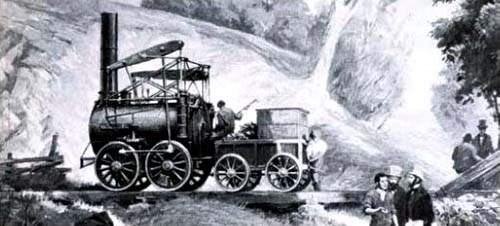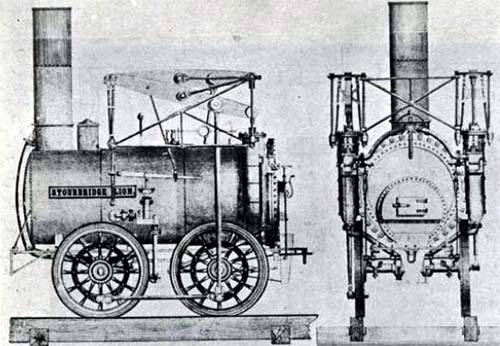|
It All Started on the D&H
STEEL WHEELS by Corporate Historian Emeritus
Jonathan Hanna

BUDGET LOCOMOTIVE: Manufacturer Foster and Rastrick undercut
Stephenson.
 In North America, the steam locomotive era started in our own backyard, on the D&H. When it was founded 184 years ago,
the Delaware & Hudson Railway Company (D&H) was actually the Delaware and Hudson Canal Company. But the D&H became the first
transportation company in North America to operate a steam locomotive.
In North America, the steam locomotive era started in our own backyard, on the D&H. When it was founded 184 years ago,
the Delaware & Hudson Railway Company (D&H) was actually the Delaware and Hudson Canal Company. But the D&H became the first
transportation company in North America to operate a steam locomotive.
Taking his life in his hands on 8 Aug 1829, the D&H's 26-year-old Horatio Allen piloted the Stourbridge Lion three miles into the
woods near Honesdale, Pennsylvania, USA... and into the history books. This great moment in history started the year before when the
young twenty something canal engineer was sent to England to check out the latest technology, steam locomotives. He came back home with
orders for, not one, not two, but four locomotives... at a total cost of more than $12,000. George Stephenson, the man who built the
world's first successful steam locomotive, the famous Rocket, sold Horatio Allen the most expensive of the four. At $3,663.30, the
"America" looked like the worst buy. So a rival locomotive manufacturer in Stourbridge, Foster and Rastrick, undercut
Stephenson for the other three locomotives: the Delaware, the Hudson, and the Stourbridge Lion. Each of the three others cost
$2,900 and change.

SHE'S SO HEAVY: The weighty, seven-ton Lion ended up as a
stationary steam generator.
The Delaware and Hudson Canal Company was formed in 1823 to get much needed Pennsylvania coal to an energy-starved New York City. Barging
it down the Hudson River to New York City was the easy part. Getting it from Carbondale to Honesdale, Pennsylvania, and then to the
Hudson River was the hard part. So the D&H excavated canals along the Delaware River. D&H's John B. Jervis came up with an
ingenious scheme, in 1826, to portage the coal over the Moosic Mountains to the canal basin on the other side. That was the year the U.S.
got its first railway, a horse-drawn six-mile railway between a quarry and a river in Quincy, Massachusetts, to haul granite for the
Bunker Hill monument. Jervis went one better. He would save money replacing horses with steam locomotives. He figured four locomotives
would cost $41.30 a day to run. Horses, on the other hand, would cost $71.87 to keep fit and fed, and required rest.
All four of Allen's locomotives arrived in New York City in the summer of 1829. After some stationary demonstrations, the Stourbridge
Lion was shipped to Honesdale where Jervis' four foot - three inch gauge railway, built of wood with iron straps, was waiting. Horatio
Allen climbed aboard the Lion, 8 Aug 1829, and rode off into history.
The locomotive ran well but the track, trestles, and wooden embankments were too rickety under its seven tons. Allen tried out the
locomotive again some days later. Same result. The Lion was too heavy for the track. So she and her sister locomotives ended up as
stationary steam engines. And the D&H's inaugural venture into the steam locomotive era came to an end. The D&H wouldn't use a
moving steam locomotive again until 1860.
|